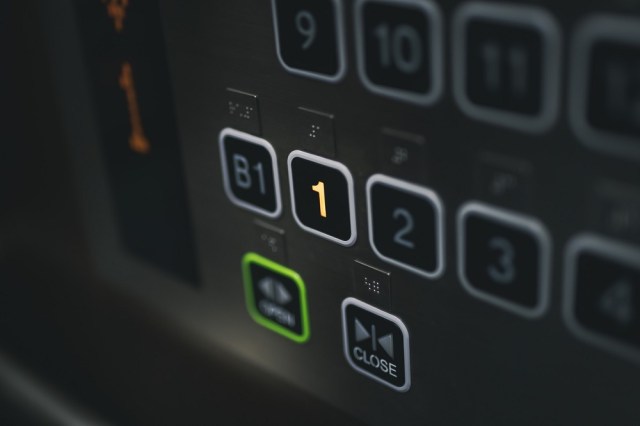What should you do if you get stuck in an elevator in an earthquake? Japan’s NHK offers five tips

And we add one of our own.
Japan has a lot of earthquakes, and also a lot of elevators. These two things aren’t entirely unrelated. The seismic activity that occurs where geologic plates meet creates mountainous geography. That means less flat land to build on, which means buildings have to be built higher instead of wider, and once they get tall enough, nobody is going to want to take the stairs.
That doesn’t make the idea of an earthquake hitting while you’re riding in an elevator, and getting stuck inside, any less scary, though. That hypothetical situation was on a lot of people’s minds last Thursday morning, after a strong earthquake shook Chiba Prefecture, Tokyo’s neighbor to the east. No serious injuries have been reported, but national broadcaster NHK felt the time was right for a reminder on what to do if you’re in an elevator during an earthquake, and offered four steps to follow, plus one additional backup piece of advice.
けさの地震でエレベーターが停止しているという情報がありますhttps://t.co/22z4jE2eOs
— NHK生活・防災 (@nhk_seikatsu) May 10, 2023
もしもの地震発生でエレベーターに閉じ込められたらどうするか、参考にして下さい#震度5強 #緊急地震速報 pic.twitter.com/PaUySuTwW9
First, if you feel the elevator start to sway from an earthquake, NHK says to quickly hit all of the floor buttons, starting with the ones closest to the elevator’s current position. If the elevator can safely move to the floor before going into a shutdown state, it will do so, allowing you to exit the elevator and seek shelter.
If the elevator does come to an emergency stop between floors, check to see if the doors have partly jerked open. If they have, the circuit will be broken, and the elevator will not resume moving even if it’s safe to do so. To restore the circuit, press the doors closed with your hands, NHK says, which will allow the elevator to move to the nearest floor if safely can.
If that doesn’t work, press the emergency call button (which will be labeled 非常呼 or 非常呼び出し in Japanese). This should connect you to emergency staff who can assist you. That said, if your elevator has stopped because of an earthquake, it may not be the only one, so you might have to try calling repeatedly before you can connect with an operator.
Last, while it might be common nature to shout out “Help!” as loud as you can, NHK recommends an alternate way of sending an audible distress signal. Using a hard object, such as a pen or coin, bang on a metallic surface of the elevator’s interior. Not only will the sound carry better to people outside the elevator who are in a position to help, you’ll also save the strength you would have used shouting yourself hoarse. Basically, the goal is to create a big noise, not necessarily a big voice.
Of course, it may take some time for help to arrive. If you’re in for a wait, take a look around the elevator’s interior, and hopefully you’ll find something labeled 備蓄ボックス, bichuki bokkusu, or “emergency supply box.”
▼ The emergency supply box may be in the corner of the elevator, like in the top left photo here.
高層ビルのエレベーターで昇降中に大地震が起きたらどうしますか?まず、停止階のボタンを全部押し、止まったところで降りて、地震が収まるのを待ってください。閉じ込めれた場合は防災備蓄ボックス(三角コーナーの非常用備品)等の有無を確認し、非常用ボタンや携帯で事実の通報をお願いします。 pic.twitter.com/52fz3ev28X
— 警視庁警備部災害対策課 (@MPD_bousai) January 31, 2023
The exact contents will vary by the individual elevator, but you should have water, some sort of preserved food like protein bars, “emergency toilets” (plastic bags for bodily waste), and maybe even such niceties as heating and cooling pads, a blanket, or even a radio.
エレベーター 防災備蓄ボックス
— ほの (@moukoinannte) February 19, 2021
ほとんどの設置場所では
建物所有者・管理者が
点検・交換をする必要があります
設置している
ビル・マンションなどの
施設管理者は中身の点検を
エレベーター内に
閉じ込められた場合に
使用する際には
備蓄されている飲料・食料の
保存期間の確認が必要です https://t.co/fAWtjKh60L pic.twitter.com/Wna8AJ4TSw
And though NHK doesn’t mention it specifically, we’ll add in one last bonus tip: don’t panic. If getting trapped in an elevator during an earthquake is something we’ve all thought about, you can be sure elevator manufacturers and building managers have thought about it too, and have plans for how to get you out.
Source: NHK News Web via Jin
Top image: Pakutaso
● Want to hear about SoraNews24’s latest articles as soon as they’re published? Follow us on Facebook and Twitter!
Credit:





0 comments: